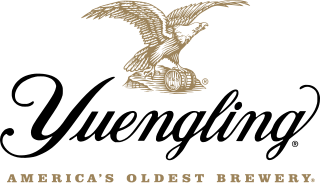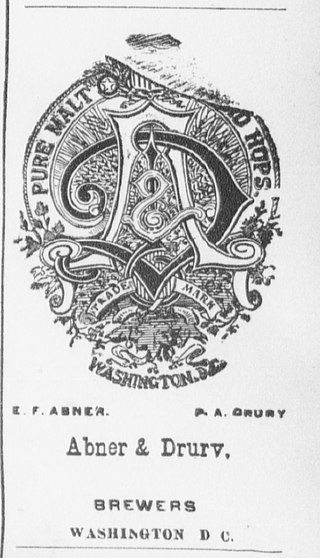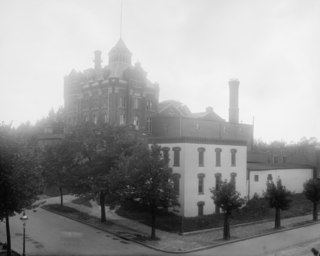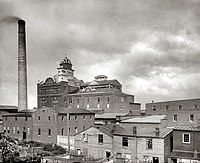
D. G. Yuengling & Son, established in 1829, is the oldest operating brewing company in the United States. In 2018, by volume of sales, it was the largest craft brewery, sixth largest overall brewery and largest wholly American-owned brewery in the United States. Its headquarters are in Pottsville, Pennsylvania. In 2015, Yuengling produced about 2.9 million barrels, operating two Pennsylvania facilities and a brewery in Tampa, Florida.

Tennent Caledonian is a brewing company based in Glasgow, Scotland.
Webster's Brewery was a brewery founded in 1838 by Samuel Webster which operated at the Fountain Head Brewery in Halifax, West Yorkshire, England. Webster's Green Label, a light mild, and Yorkshire Bitter gained national distribution after the company was taken over by Watney Mann in 1972. Throughout the 1970s it was known for the advertising slogan: "Drives out the northern thirst".

Full Sail Brewing Company is a craft brewery in Hood River, Oregon, United States. Founded in 1987, Full Sail was the first commercially successful craft brewery to bottle beer in the Pacific Northwest for retail sale, and one of Oregon's early microbreweries. The first beer packaged was Full Sail Golden Ale, followed in 1988 by Full Sail Imperial Porter, Full Sail Amber Ale, and Wassail Winter Ale.
Beer in Africa, especially lager, is produced commercially in most African countries, and indigenous people also make varieties of beer. Beer is served in various locales, from neighbourhood shebeens to upscale bars. Many countries have standardized beer bottle sizes, which are cleaned and re-used, so when buying beer at a store, people often must pay a deposit on the bottle and the price of the beer. An alternative to glass-bottle beers is local beer sold in tetra-pak style paper cartons.

Big Sky Brewing Company is a brewery and taproom located in Missoula, Montana. It is owned by three partners, Bjorn Nabozney, Neal Leathers, and Brad Robinson. It is Montana's largest brewery. It first opened its doors in 1995 on 120-A Hickory Street, but eventually moved to its current location at 5417 Trumpeter Way. The brewery features both seasonal and regular ales and has continued to function under the same owners for twenty-three years.

Wrexham Lager is a lager brewed in Wrexham, north-east Wales, tracing its heritage to 1881. After the original brewery's closure in 2000, the brand was revived by the Roberts family in 2011 using an older recipe.
The Matilda Bay Brewing Company is a brewery founded in Western Australia, the first new brewery opened in Australia since World War II, and Australia's first craft brewery. Originating from small batches brewed for the Sail and Anchor Hotel in 1984, their main brewery opened in 1989 in a prominent building at Stirling Highway previously occupied by Ford Motor Company. The company was purchased by Carlton & United Breweries in the early 1990s.

National Bohemian Beer, colloquially Natty Boh, is an American lager originating from Baltimore, Maryland. It was first brewed in 1885 by the National Brewing Company, but was eventually purchased by Pabst Brewing Company.

The Christian Heurich Brewing Company was a Washington, D.C., brewery founded in 1872 and incorporated by Christian Heurich in 1890. First located near Dupont Circle on 20th Street NW, it expanded to a much larger site in Foggy Bottom in 1895 after a major fire. The new brewery was located along the Potomac River at 26th Street and D Street NW, where the John F. Kennedy Center for the Performing Arts now stands. The Heurich brewery was the largest in Washington's history, capable of producing 500,000 barrels of beer a year and 250 tons of ice daily.

The Valentin Blatz Brewing Company was an American brewery based in Milwaukee, Wisconsin. It produced Blatz Beer from 1851 until 1959, when the label was sold to Pabst Brewing Company.

Emu is a beer brand name now owned by Lion. It was originally brewed by the Emu Brewery in 1908 until the brewery's sale to the Swan Brewery in 1927. The production of the Emu branded beer continued from a separate autonomous brewery in Perth until 1978, and then was relocated to a combined brewery in Canning Vale. In 2014 Lion Nathan moved production of both the Emu and Swan beer brands to the company's West End Brewery in Adelaide. Following the closure of the West End Brewery in October 2020, it was announced that Swan and Emu branded beer would be brewed at either the Castlemaine Perkins brewery in Brisbane or Tooheys Brewery in Sydney.

The original Fred Koch Brewery was a small, independent brewery in Dunkirk, New York that produced beer and ale from late 1888 until 1985. Production peaked in the early 1950s with over 100,000 barrels brewed annually. When the Dunkirk, New York brewery was closed in 1985, it was located at 15-25 West Courtney Street.
The Storz Brewing Company was located at 1807 North 16th Street in North Omaha, Nebraska. Established from a company started in 1863, Storz Brewing began in 1876 by Gottlieb Storz and was owned by the Storz family until 1966; the brewery ceased operations in 1972. Their beers won several prizes in international competitions, and Storz was the top selling brand in Nebraska starting in World War II. Storz was one of the "Big 4" brewers located in Omaha, which also included the Krug, Willow Springs and Metz breweries. On August 8, 2013, it was announced the brand would be revived by Tom Markel, nephew of Monnie Storz Markel, the granddaughter of Gottlieb Storz, with his cousin John Markel, son of Monnie Storz Markel as investor.

Camerons Brewery is an English brewery established by John William Cameron in Stranton, Hartlepool, County Durham, in 1865. It is the largest independent brewer in the North East of England, with a brewery capacity of 1.5 million hectolitres and a tied estate of 75 houses. It is one of the oldest industrial concerns in Hartlepool, and has historically been one of the largest employers.
Christian Heurich was an American brewer and real estate investor in Washington D.C. His company, Christian Heurich Brewing Company, established in 1872, was the largest brewery in Washington, D.C. At one point, Heurich owned more land than any other landowner in Washington, D.C., except the federal government.
George Juenemann (1823–1884) co-owned and operated Humphrey and Juenemann's Pleasure Garden, a Washington DC brewery and early example of an American beer garden. The facility was also known as Juenemann's Brewery.

The Abner-Drury Brewery, operating from 1898 to 1938, was a brewery in the Foggy Bottom neighborhood of Washington, D.C. The brewery went into bankruptcy on July 31, 1935, and subsequently reorganized as Washington Brewery, Inc. It went out of business permanently in August 1938.

The Washington Brewery Company was a beer brewery in Washington, DC. It operated from 1890 to 1917 on Square 811.

The city of Milwaukee in the U.S. state of Wisconsin has been associated with beer throughout its history. This heritage can be found in its Major League Baseball team, the Milwaukee Brewers, and on beer brands such as Old Milwaukee and Milwaukee's Best. The city's major brewers have included Miller, Pabst, and Schlitz. MillerCoors, the city's largest brewery, produces 10 million barrels of beer a year.


















